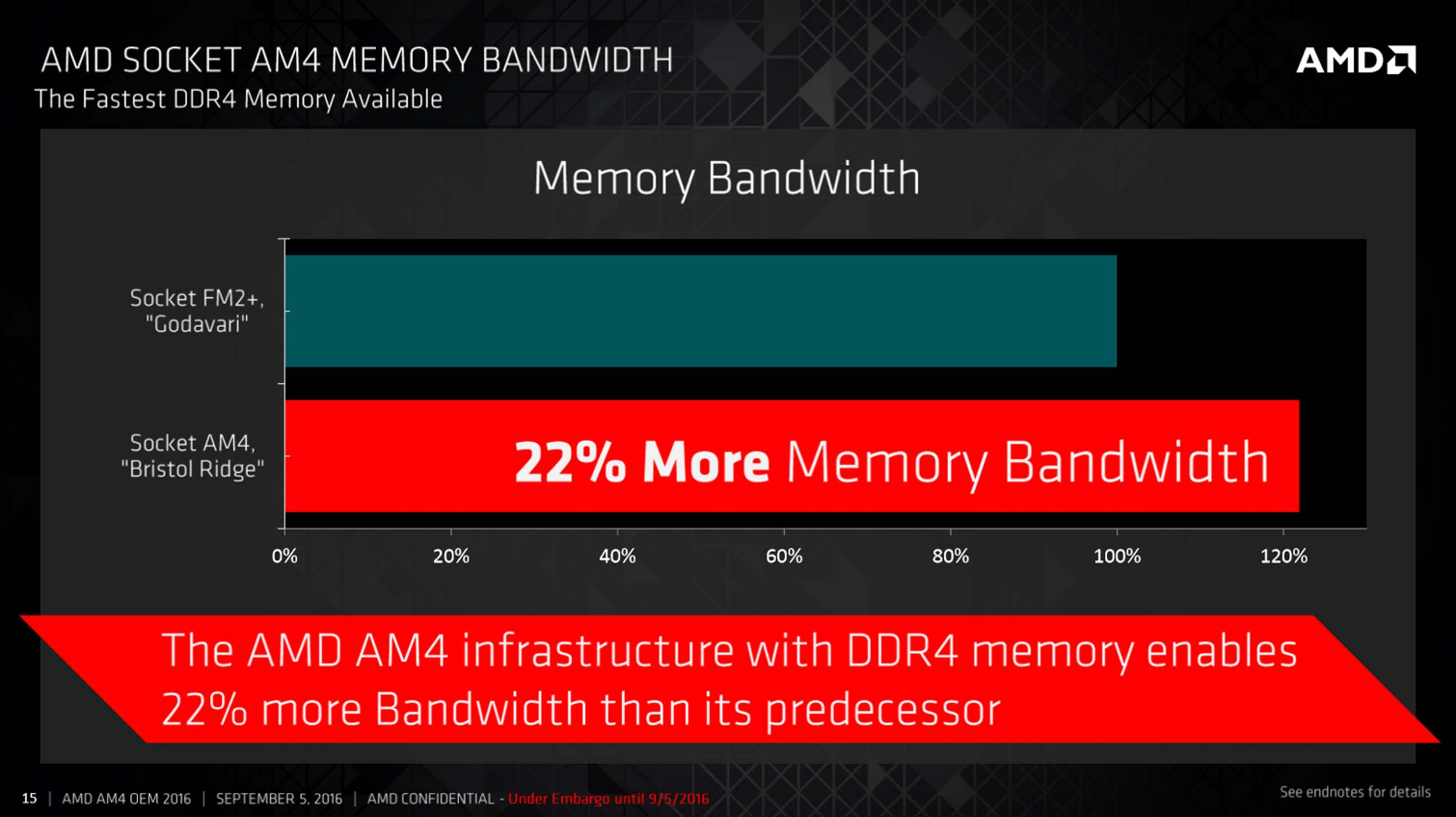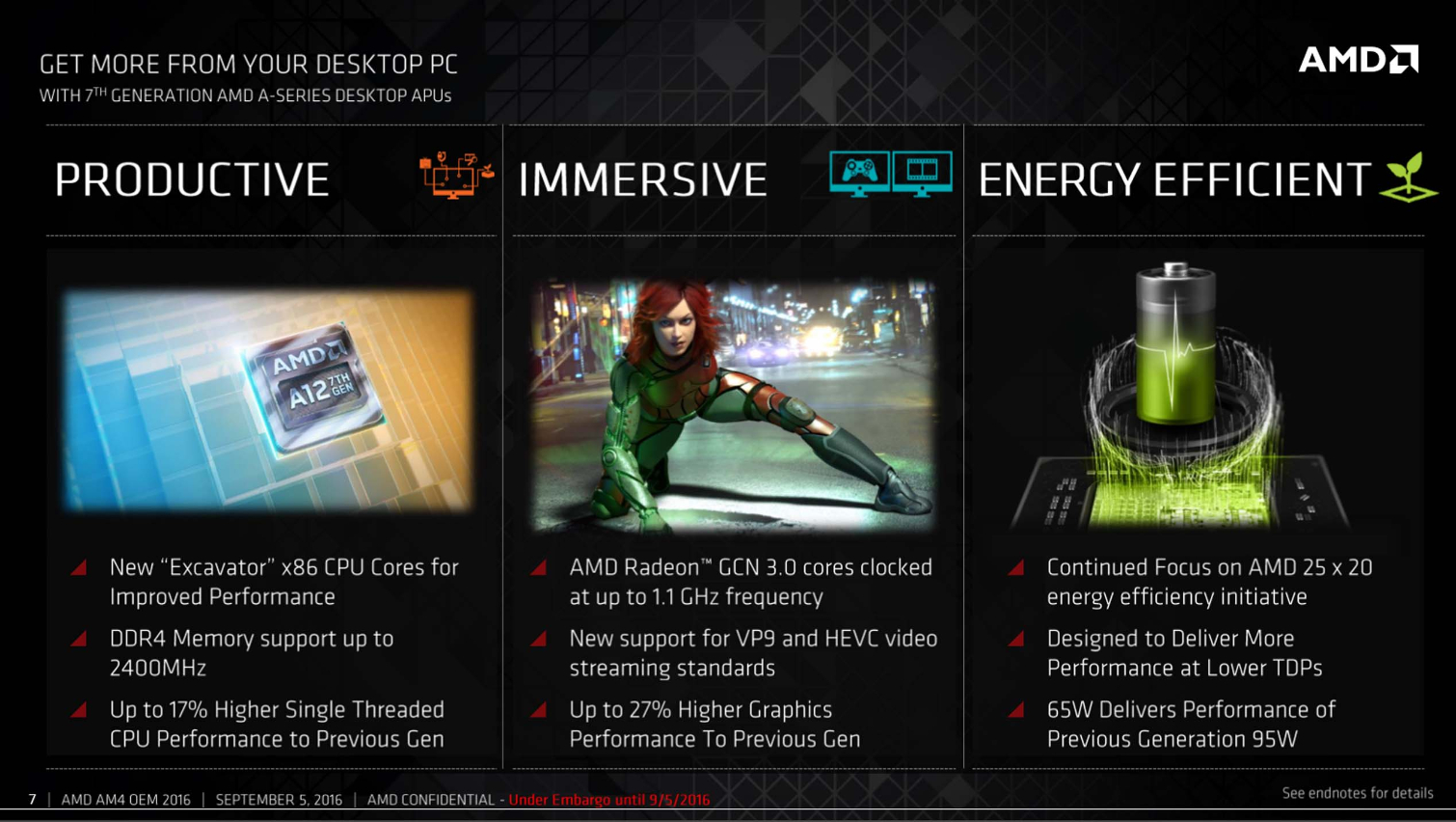AMD's AM4 Socket Comes To Fore; HP and Lenovo Shipping 7th Gen Bristol Ridge APUs
AMD announced the global launch of its 7th-gen Bristol Ridge APUs, which comes bearing the familiar 28nm Excavator cores, but the real news is that the new entry-level chips come sporting the much-anticipated AM4 socket. AMD has remained somewhat coy on the details of its newest socket, which will double as the host for its new line of Zen CPUs, but the release gives us a great indication of what to expect in the future.
The Chipsets
AMD stratified the AM4 chipset into four different configurations that offer varying features for each target segment. In the past, AMD APUs leveraged the FM2+ socket, but FX-Series CPUs used the AM3+ socket. AM4 marks the move to a single unified socket for both CPUs and APUs.
The new AM4 alignment includes X/B/A300 configurations for small form factors, A320 for essential applications and B350 for mainstream offerings. The as-of-yet unannounced (TBA) enthusiast chipset, which will power the forthcoming Zen CPUs, remains somewhat shrouded. It's logical to assume that it will provide "more" of the core feature set (such as more PCIe lanes, DDR4 memory channels, etc.). In either case, AMD intends to support the AM4 platform for the foreseeable future.



The 7th-gen APUs support PCIe 3.0 x8, two-channel DDR4 (up to 2400 MHz), USB 3.1 Gen 2 and two SATA + x2 NVMe, or two SATA + x2 PCIe configurations. The B350 (65W SKU) and A320 (35W SKUs) chipsets feature two different levels of connectivity, with the primary differentiation centering on varying PCIe lane support and USB functionality.
NVMe support is a no-brainer, but SATA Express will have limited applicability. The SATA Express specification launched in August 2013 with the SATA 3.2 spec, but we have yet to see any products on the market that use the (essentially) DOA interface.
Chipset Improvements
AMD indicated that the move to DDR4 offers a bandwidth increase of 22%, which we expected, but it also purportedly reduces TDP by 70% compared to the AM3+ chipset.


The SKUs
AMD carved the A-Series up into the familiar A12, A10, A8, Athlon and A6 segments. The breadth of the offerings spans eight different SKUs, with six 4-core offerings with Radeon R7 Graphics and two dual-core A6 variants with Radeon R5 graphics. The beefy A12-9800 provides a max/base frequency of 4.2 / 3.8 GHz with Radeon R7 graphics (8 CUs @ 1108 MHz max). AMD indicated that the 65W SKUs offer the same performance as the previous-gen 95W parts, which is a substantial improvement.
Get Tom's Hardware's best news and in-depth reviews, straight to your inbox.
The lower end of the spectrum finds the 35W A6-9500E with a max/base frequencies of 3.4 / 3.0 GHz and R5 graphics with 4 CUs and a max frequency of 800 MHz. The four-core 65W Athlon X4 950 slots in with max/base frequencies of 3.5 / 3.8 GHz, but lacks graphics cores.


Movin' On Up
AMD indicated that the new 65W A12-9800 offers the same performance as the Intel i5-6500 at 65W during a subset of the PCMark 8 benchmark, and that the 35W A12-9800E offers 17% more performance than an Intel i5-6500T at 35W. The company also touted 99% and 88% more 3D Mark 11 performance with the respective processors head-to-head.
AMD also provided performance-per-Watt measurements that it recorded during the PCMark and 3D Mark tests, which the company claimed highlights a marked efficiency improvement. DDR4 sips power compared to its DDR3 predecessor, so we suspect that the bulk of the efficiency improvement is associated with reduced DDR4 power consumption.


The Media Bits
The A-Series APUs also feature support for up to UHD 4K H.264 and H.265 and HEVC codecs, along with a smattering of 1080p VP9, 4K MJPEG and VC-1 support, among others, which should level the media playing field with Intel.
But When?
HP and Lenovo are leading the charge to market, and the normal crowd of OEMs will soon follow, but there is no firm date set for retail products, and we have no word on pricing yet, either. The 28nm A-Series Bristol Ridge APUs are intriguing, but the enthusiast world is salivating for the 14nm Zen that AMD has waiting in the wings. The AM4 chipset improvements are important to bring the Zen platform up to speed with current-generation Intel offerings, and the move to DDR4 and faster USB interfaces should fit the bill nicely.
Edit: 9/16/2016 7:35 PM PST - moved sentence to correct location.

Paul Alcorn is the Editor-in-Chief for Tom's Hardware US. He also writes news and reviews on CPUs, storage, and enterprise hardware.
-
joex444 > In the past, AMD APUs leveraged the FM2+ chipset, but FX-Series CPUs used the AM3+ chipsetReply
Chipset -> Socket. -
RomeoReject Hoping that the higher up models will allow a little bit more DDR bandwidth. 2400MHz seems a hair slow by DDR4 standards.Reply -
Paul Alcorn Reply18558085 said:> In the past, AMD APUs leveraged the FM2+ chipset, but FX-Series CPUs used the AM3+ chipset
Chipset -> Socket.
Thanks for the quick eye :no: Joex444, fixed! -
TechyInAZ Very impressive for the A12 to actually compete directly with a skylake Core i5. I hope that is legit for other real world applications.Reply -
problematiq Reply18558097 said:Hoping that the higher up models will allow a little bit more DDR bandwidth. 2400MHz seems a hair slow by DDR4 standards.
I'm not 100% sure but it may just be referring to the small form factor APU's. The higher end will support faster I would suspect.
That or it's referring to the top standard which is 2400 I believe. Anything past that is considered overclocked. Again I'm not 100% sure. -
Cryio Reply18558097 said:Hoping that the higher up models will allow a little bit more DDR bandwidth. 2400MHz seems a hair slow by DDR4 standards.
The Athlon and APUs are low budget PCs. You won't expect people to invest in RAM more than the cost of the APU itself.
Zen will be the one who will leverage 4000+ MHz DDR4 modules. -
tiagoluz8 Performance Per Watt graphs are very biased, they changed the 65W Intel CPU with a 91W one and moved that 65W CPU to compare with the 35W AMD one. The thing with Intel is, you have an upgrade path, if you need. The best APU here matches the i5-6500, which can be upgraded up to an i7-6700K, miles ahead.Reply -
IceMyth What worries me more is the talk about Zen+ which might need AM4+ MB which might come 1 year after release of Zen!Reply

